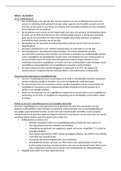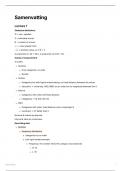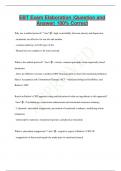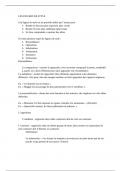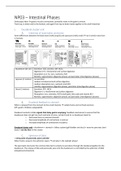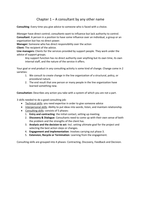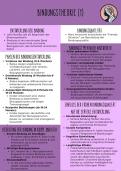Glossary
& Agency problem – the likelihood that managers may place personal goals ahead of corporate goals.
& Auction markets – are markets where transactions are done by means of a process of public
outcry.
& Capital markets – a market that enables suppliers and demanders of long-term funds to make
transactions.
& Corporate governance – the system used to direct and control a company. Defines the rights and
responsibilities of key corporate participants, decision – making procedures and the way in which the
firm will set achieve and monitor objectives.
& Dealer markets – the market in which the buyer and seller are not brought together directly but
instead have their orders executed by securities dealers that make markets in the given security.
& Dividend - is a distribution of profits by a corporation to its shareholders. When a corporation
earns a profit or surplus, it is able to pay a proportion of the profit as a dividend to shareholders.
[expense].
& Ethics – Basic concept of decent human behaviour. Includes fundamental principles that define the
character or guiding beliefs of a person, group or institution.
& Maximizing shareholders’ wealth – Obtaining the greatest wealth for shareholders based on
their number of shares and highest possible share price.
& Maximizing the rate of return – yielding the largest ratio of net after tax profits to total assets.
& Money markets – a financial relationship created between suppliers and demanders of short-term
funds.
& Profit maximization – the desire to yield the highest monetary return
1. Define Financial Management
® Financial management can be described as the process of creating value for the organisation
and its stakeholders.
® Value can be created by reducing costs however to be more specific financial management entails the
use of different forms of capital to maximize the net present value (NPV) of business opportunity
decisions by reducing the weighted average cost of capital (WACC).
In order to understand the role of financial management we need to understand how it differs from
financial accounting, cost accounting and management accounting.
, Financial accounting Cost accounting Management accounting
The representation of both Focuses specifically around past Deals with quantitative (figures)
organisations’ financial activity and present costs related to and qualitative (decisions and
and financial position during a specific products. reasoning) in the preparation of
financial period (based on past budgets and forecasts in making
information) and communicating It also looks at how these costs viable and valuable future
this performance to can be controlled. decisions.
organisations stakeholders.
(Mostly external) Used for the management of the
internal functioning or a business
ê Financial accounting which can be described as “looking back” in terms of recording
historical data, while
ê Financial management can be described as “looking forward” as it seeks to create value
into the future whilst having a sound understanding of the data and operations in the past.
Figure 1: Difference between financial accounting, cost accounting and management accounting
1.1 Finance function and marketing function
• Same core purpose manifested in different ways.
• Marketing has a strong connection with financial performance.
• The functions are linked by the same primary organisational goal
(to maximise shareholder wealth)
• By working together in a harmonious manor a competitive advantage can be created and the
common organisational goal can be reached.
,Finance Marketing
Core purpose is to Maximise shareholder Core purpose is to maximise shareholder
wealth via wealth via the “task of developing and
• Appropriate financing and managing market-based assets, or assets
investment decisions, that arise from the commingling of the firm
• cost reduction, with entities in its external environment.
• financial restructuring
• financial planning. Market-based assets include:
• customer relationships
• channel relationships
• partner relationships.
This assets influence shareholder value by:
• accelerating and enhancing cash
flows
• lowering the volatility and
vulnerability of cash flows,
• increasing the residual value of cash
flows”
(Srivastava, Shervani & Fahey 1998:16).
How marketing affects financial
performance:
• Marketing affects the share price of
an organisation due to its effect on
‘market share and profitability’
(Lovett & MacDonald, 2005:476).
• Marketing can also influence the
‘perception of analysts and
investors’ (Lovett & MacDonald,
2005:476).
2. Defining corporate finance
® Summarises one of the key business functions (4)
o (The financial function which is concerned with the flow of cash in and out of an entity)
o Decisions related to the procurement of financial capital, application of capital (financing decisions,
Investment decisions)
o Includes all facets including planning, organising, directing and controlling
2.1 Financial accounting vs financial management
∆ Financial accounting:
• The representation of both organisations financial activity and financial position during a financial
period (based on past information) and communicating this performance to organisations
stakeholders. (mostly external)
• Accountants record financial activities via financial statements
• Historical perspective
• Looks at past activities
• Provide financial management with accurate, up-to-date info to best make decisions
,∆ Financial management / corporate finance:
§ Focus on creating value in future
§ Forward looking perspective
§ Linked to economics -make decisions within a constantly changing economic environment
§ Economic indicators such as GDP, inflation, interest and exchange rates are used to make
informed decisions
§ Financial management like economics try to use limited resources in the best way to increase
shareholders wealth
§ Need to keep a close eye on inflation rate – influences prices of resources (high inflation and
volatile SA rand have become major sources of concern for local importer and exporters and
contribute to SAs declining attractiveness as an international investment destination)
3. The Financial manager
• Responsible for the organisation’s financial management activities
• Faced with 3 financial management decision: Capital budgeting, capital structure and working-capital
management (discussed further down)
• What we do – according to sir -managing cash, credit, finance planning, corporate expenditure
3.1 Roles and responsibilities
® The role of financial managers continues to evolve and grow over time. Managers must therefore keep
up to date with market trends and research or they will run the risk of becoming antiquated, to the
cost of their career, their organisation and the shareholders.
® NOTE: financial manager = financial director = Chief Financial officer (CFO)
In charge of:
o Cash resources
o Credit department
o Capital expenditures
o Financial planning
o Tax affairs
o Recordkeeping
® These differ from business to business on a daily basis thus entities must employ staff with the
appropriate qualifications and relevant experience, and one who exhibits the highest level of integrity
3.2 Financial Management decisions
® These decisions determine whether an entity will create value in the long run. In a small entity these
functions and decisions are made by the owner.
All can be seen when looking at a statement of financial position/ balance sheet
∆ Capital budgeting/ capital projects / capital investments
® Process of evaluating and selecting long-term investments that are consistent with the firm’s goal of
maximising owner wealth.
o Decides which non-current assets should be invested in e.g. Machines
o Acquisition and management of non-current assets
o Aim to create value thus invest in value-adding non-current assets.
o To determine if value will be added use the NPV = Net Present Value
, ∆ Capital Structure:
® Combination of equity and debt the business uses to finance itself.
o Where long term financing is obtained. (For short-term assets too)
o Decision concerns a mix of debt and equity that the entity uses to fund its activities.
o (own savings, raise funds, retained earnings, borrow money , issue ordinary and preference
shares or bonds if PLC)
o Decisions will effect an entity from the risk and value perspective
o Must consider risk and cost when choosing finance options
o When management decides to issue bonds or shares to the public, remember the expenses are
high
o Specific mix of equity and debt must be considered.
∆ Working-capital management:
® Defined informally as the money needed by the firm as a “float” to meet day-to-day expenses.
o More formally, working capital represents the difference between current assets and current
liabilities. (Marney & Tarbert, 2011).
o How day-to-day financial activities will be managed. (Managing cash, inventory and paying short-
term obligations.)
o The short-term assets and liabilities of an entity (cash, inventory, trade-receivables, trade
payables)
o Depends on day-to-day management of short-term assets
o Cash or credit basis
o Credit = payment terms
o Discounts for early payments
o Cash or credit when buying from suppliers.
o Decisions made to ensure entity functions efficiently and sufficient resources are available for it
to remain and profitable and liquid.
3.3 Goals of financial management Financial management goals
® Decisions made by managers are guided based on 3 goals.
® First 2 focus on the historical performance of an entity
o Profit maximisation:
§ To do so, entities revenue needs to be increased and operating and other expenses
need to be decreased. (+turnover and – costs)
§ This can be done though: more effective marketing campaigns and increasing
productivity, reducing waste, streamlining production process and using cost-effective
sources of debt funding.
§ Extreme cost cutting not suggested – could risk health and safety of employees,
customers and communities.
§ Flaws: (reasons for failure when alone)
´ Accounting profit can be manipulated.
´ The goal ignores timing and risk associated with generating the profit.
, o Maximising rate of return:
§ To overcome the shortcomings of profit maximisation businesses can focus on the ratio
of net after tax profits to total assets instead of maximising net profit after tax.
§ The rate of return will indicate whether management has achieved the most out of the
investment.
§ Rate of return is a % that offers the advantage that several investments can be
compared with one another.
§ Flaws:
´ Inputs are accounting values (net profit and total assets) thus can still be
manipulated.
´ Timing and risk associated with generating the profit are also ignored.
o Maximising shareholders wealth:
§ The past cannot determine the future. If only the past is looked at the entity will not be
able to grow.
§ Forward looking goal centred on increasing wealth for owners, shareholders and firm.
§ The shareholder’s wealth is determined by the number of shares owned and the current
share price. Example page 10 Tiger Brands
§ Shareholder primacy = financial managers only engage in activities that will have a
positive influence on an entities current share price.
´ Goal creates a fixation on short-term results, fuelling inequality, environmental
degradation, and excessive executive remuneration.
´ Stake holder and shareholder needs have to be balanced.
§ By issuing shares to shareholders, an organisation is able to raise funds and the return
on the share from a shareholders’ point of view is seen through the capital growth in
the share price or dividends.
§ Shareholders’ wealth is thus determined by the number of shares and the current share
price, which may vary from day to day. Thus, the financial manager must engage in
activities, which will have a positive effect on the firms share price.
Other goals may include:
• Maximising earnings per share
• Market value added
• Economic value added
4. NPV – Net Present Value
To calc you need to know:
o Size
o Timing
o Risk of cashflows that will be generated by the investment
® Cash inflows: money coming into the entity such as receiving money for rent
® Cash outflows: Owner spends money – pays supplier
Future cashflows have to be reduced due to the uncertainty associated with these cash flows accruing.
WACC – weighted average cost of capital is used as an appropriate discount rate.
ê If present value of an assets cash inflows exceeds cost – we say asst has a positive NPV (thus
deemed a value-adding investment.)


